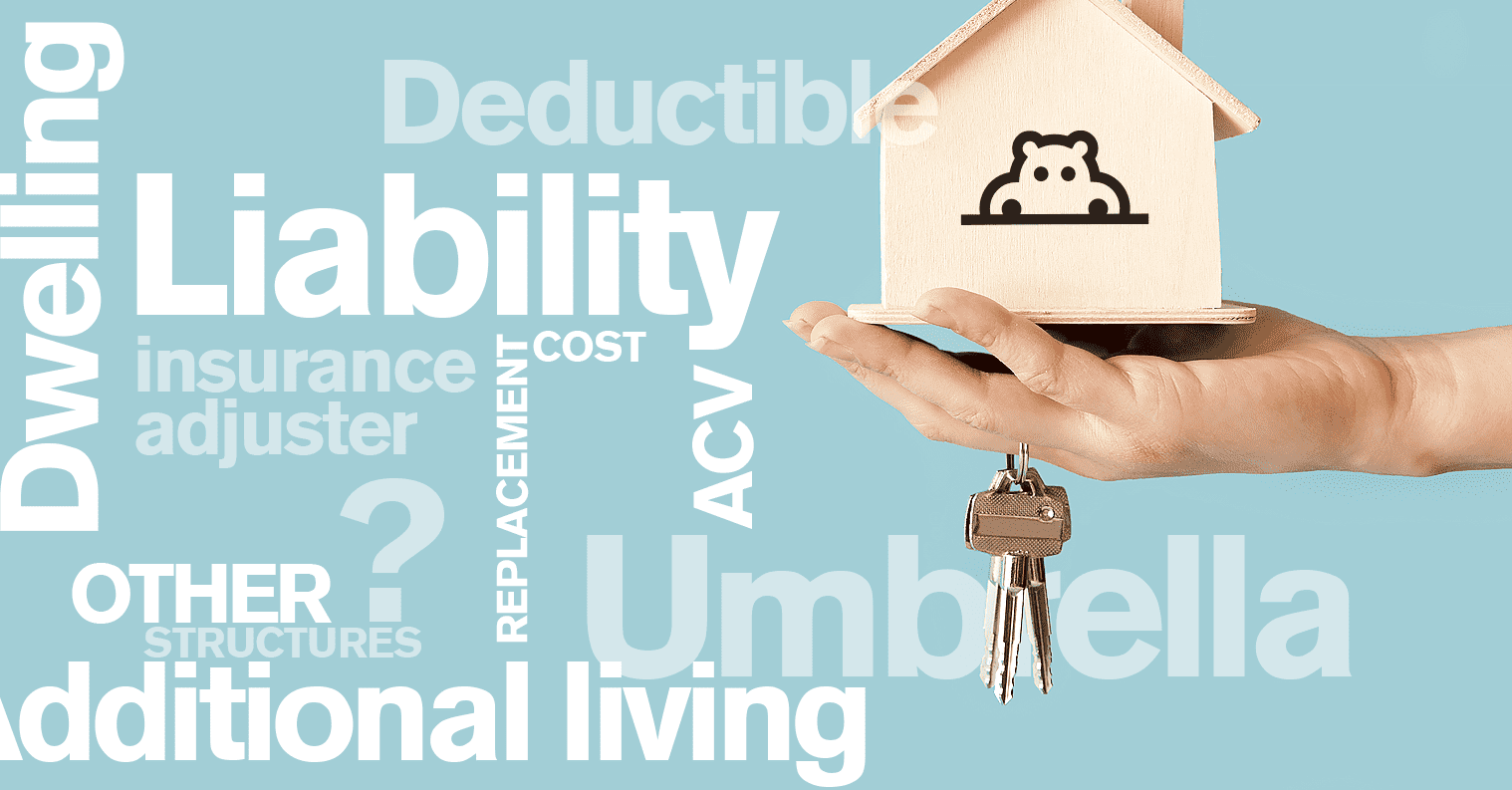Homeowners insurance terms and definitions

Homeowners insurance terms can seem like a different language, filled with confusing jargon and complex concepts. Understanding these terms is key to protecting one of the biggest investments you'll ever make — your home.
Hippo believes that helping customers make informed decisions about protecting their greatest financial asset ultimately provides a level of comfort and security in understanding precisely what they need, what they don’t need, and how to build a great policy.
Don’t let dense jargon intimidate you. This guide translates the core homeowners insurance terms you need to know into simple, straightforward definitions. Finding the right policy will be easy once you conquer the terminology.
Key takeaways
-
Homeowners insurance policies are filled with unfamiliar language that can seem overwhelming.
-
Cutting through this jargon will allow you to find the perfect policy for your needs.
-
This guide breaks down the most important homeowners insurance definitions and terms you need to know.
-
As you shop for a policy, ask your insurance agent to clearly explain home insurance terms.
Home insurance terms and definitions explained
All homeowners insurance policies are comprehensive agreements with dozens of elements and subcategories of coverage that cater to your needs. Yes, there's plenty of fine print – and you should read it all – but you need to understand some essential home insurance terms when evaluating your policy. Let's go over those now.
Homeowners insurance deductible
An insurance deductible is the amount of money you're responsible for paying toward a claim before your insurance company reimburses you. It's how policyholders and insurers share the cost of coverage.
When you sign up for a policy, you choose your deductible amount. Usually, a higher deductible means you’ll pay lower monthly premiums. But if you file a claim, you’ll have to pay more upfront before insurance steps in to cover the rest, up to policy limits.
For example, if you have a $1,000 deductible and file a claim for $10,000 in covered damage, you would pay the first $1,000 while your insurer covers the remaining $9,000.
Insurance binder
An insurance binder is a temporary document that serves as proof of coverage until your formal policy is issued. It's a legally binding agreement between you and the insurance company. It outlines essential coverage details, including the type of insurance, policy number, effective dates, coverage limits, and deductibles.
Binders are often used when you need to provide proof of insurance quickly, like when closing on a home or refinancing. They’re typically valid for up to 90 days, after which the insurance company will issue your permanent policy documents to replace the binder.
Homeowners insurance declaration page
An insurance declaration page is a summary of your insurance policy that provides an overview of your coverage. It includes essential information such as your policy number, effective dates, insured property address, coverage limits, deductibles, and any optional endorsements or riders.
The declaration page also lists the premium you'll pay for the policy term. It serves as proof of insurance and is often required when refinancing or obtaining a mortgage. If you need to file a claim or have questions about your coverage, the declaration page is a quick reference guide to your policy's key details.
A peril
A peril is a specific risk or cause of loss covered by an insurance policy. Some common perils home insurance covers are fire, theft, and windstorms.
Homeowners insurance policies typically cover perils in two ways: named perils and open peril policies.
-
A named perils policy covers only the specific risks listed in your policy documents.
-
An open perils policy covers all risks except those explicitly excluded.
The perils covered by your policy will determine what types of losses are insured, but they can vary depending on your policy. Understanding the definition of insurance terms—like what is a peril—can help you know exactly what losses your policy covers.
Owner's title insurance
Owner's title insurance protects your ownership rights as a homebuyer if there are any defects or disputes over the property title after closing.
When purchasing a home, there could be issues with the property's title, such as unknown liens, outstanding property taxes, clerical errors or other issues missed during the title search process.
Owner's title insurance protects you from financial losses related to these title defects. It's a one-time premium paid at closing and remains effective as long as you own the property.
While lender's title insurance is typically required, owner's title insurance is optional but highly recommended to safeguard your investment.
Insurance endorsement
An insurance endorsement is an amendment or addition to an existing insurance policy that modifies the terms of the original policy. Endorsements can add, remove, or alter coverage depending on the policyholder's needs.
For example, a homeowner might add a valuable items endorsement to their policy to provide extra coverage for high-value possessions like jewelry or art. Endorsements can also remove certain exclusions, increase liability limits, or add named insureds to the policy.
Essentially, endorsements allow you to customize your insurance coverage to better suit your specific needs. Once added, endorsements are legally binding and become part of the insurance contract.
-
Synonym: insurance rider
Insurance adjuster
An insurance adjuster is the professional your insurance company assigns to evaluate and manage your claim after you report a loss. They investigate to determine if the incident is covered and then provide an estimate of repair or replacement costs.
Adjusters are responsible for filing, assessing and ultimately paying out on your claim. They may be employees of the insurance company (staff adjusters) or independent contractors (independent adjusters). Their main goal is to ensure that claims are handled fairly and by the policy terms.
Insurance adjusters shouldn't be confused with another popular term — insurance agents. Agents are the people who sell policies and help clients choose the right coverage for their needs.
Insurance limits
Insurance limits refer to the maximum amount your homeowners insurance policy will pay for a covered claim. Limits are typically set for different types of coverage within a policy, such as personal property, liability, or medical payments.
For example, your policy might have a $300,000 limit for the dwelling coverage to rebuild your home after a fire. Or a $100,000 limit for liability protection if someone gets injured on your property and sues.
Limits define the insurer's maximum financial obligation for different types of claims. Any costs exceeding those limits become your out-of-pocket responsibility as the homeowner.
Insurance exclusions
An insurance exclusion is a provision in an insurance policy that specifies certain risks, events, or circumstances that aren’t covered under your policy. Exclusions limit the scope of coverage and help insurance companies manage their risk exposure.
Common exclusions in homeowners insurance policies include damage caused by floods, earthquakes, or intentional acts. For example, if your policy has a flood exclusion and your home sustains water damage due to a flood, your insurance company will not cover the repairs.
Review and understand the exclusions in your policy to know what is and isn't covered.
Insurance premium
An insurance premium is the amount you pay your insurance company to keep your policy active. Premiums are typically paid monthly, quarterly, or annually, depending on the insurer and the policy.
Insurance companies calculate premiums based on your specific risk profile, the coverages included in your policy, and the deductible amounts you choose.
For example, if you have a homeowners insurance policy with an annual premium of $1,200, you might pay $100 monthly to maintain coverage. Failing to pay premiums can result in policy cancellation.
Insurance score
An insurance score is another homeowners insurance definition you need to know. It’s a numerical rating used by insurance companies to assess the likelihood of a policyholder filing a claim. It’s based on various factors, including credit history, and other relevant information. Insurance scores are similar to credit scores but are specifically tailored for insurance purposes.
A higher insurance score indicates a lower risk to the insurer, which may result in lower premiums. Conversely, a lower insurance score may lead to higher premiums or difficulty obtaining coverage.
It’s estimated that 85% of home insurance companies use insurance scores to calculate premiums in states where it’s legal.
-
Synonym: credit-based insurance score
Homeowners insurance coverages
Homeowners insurance typically includes several types of coverage:
-
Dwelling coverage: Insures the structure of your home against covered perils.
-
Other structures coverage: Covers detached structures like garages or sheds.
-
Personal property coverage: Protects your belongings inside the home.
-
Loss of use coverage: Pays for additional living expenses if you can't live in your home due to a covered loss.
-
Personal liability coverage: Protects you against legal claims if someone is injured on your property.
-
Medical payments coverage: Covers medical bills for guests injured on your property, regardless of fault.
Most companies bundle these home insurance coverages together into a single policy. Each policy limit often depends on your home, contents, and insurance needs.
Types of homeowners insurance
There are several types of homeowners insurance policies, designated as HO-1 through HO-8. You may see these terms pop up as you shop for home insurance:
-
HO-1 (Basic Form): Offers minimal named perils coverage for the dwelling only. Rarely offered today.
-
HO-2 (Broad Form): Provides named perils coverage for the dwelling and personal property.
-
HO-3 (Special Form): The most common policy, offering open perils coverage for the dwelling and named perils for personal property.
-
HO-4 (Tenant's Form): Renters insurance policy that covers personal property and liability.
-
HO-5 (Comprehensive Form): Provides open perils coverage for both dwelling and personal property.
-
HO-6 (Condo Form): Insurance for condo owners, covering personal property, liability, and certain structural elements.
-
HO-7 (Mobile Home Form): Similar to HO-3 but designed for mobile and manufactured homes.
-
HO-8 (Modified Coverage Form): Named perils policy for older homes with unique risks.
Levels of coverage
Home insurance offers different levels of coverage for your physical structure and personal items. Understanding the different coverage options and their definitions will help you select the right policy limits.
-
Actual cash value (ACV): Reimburses you for the depreciated value of your home or belongings at the time of the loss. It factors in age and wear and tear.
-
Replacement cost value (RCV): Covers the cost to repair or replace your home or belongings with materials of similar kind and quality without deducting for depreciation.
-
Extended replacement cost: Provides a specified percentage (usually 20% to 25%) above your dwelling coverage limit to account for unexpected reconstruction costs.
-
Guaranteed replacement cost: Pays to rebuild your home as it was before the loss, even if it’s greater than your policy limit.
Actual cash value
Actual cash value is another homeowners insurance term you should know. It's a method of valuing property for insurance purposes, which considers the depreciation of an item due to age, wear and tear, and other factors.
In the event of a covered loss, ACV is calculated by determining the item's replacement cost and then subtracting the depreciation. For example, if your five-year-old laptop is stolen, the ACV payout would be the current cost of a similar laptop minus five years of depreciation.
ACV coverage is typically less expensive than replacement cost value (RCV) coverage, but it also means you'll receive less money when filing a claim.
Replacement cost
Replacement cost is a method of valuing property for insurance purposes that doesn’t factor in depreciation.
In the event of a covered loss, RC coverage pays for the cost to repair or replace the damaged property with materials of similar kind and quality, without deducting for age, wear and tear, or other factors that could decrease its value.
For example, if your five-year-old laptop is stolen, the RC payout would cover the cost of a new laptop with similar features and specifications up to your policy limit. RC coverage is typically more expensive than actual cash value (ACV) coverage but offers broader protection.
Liability insurance
Your homeowners insurance policy will likely have a liability component that protects you and your family from legal claims resulting from injuries that occur on your property. Liability can also cover medical costs, compensation for these damages, and legal fees for your defense.
Umbrella policy
An Umbrella Policy provides extra liability coverage, an added layer of protection to your standard policy, to protect against lawsuits stemming from damages to other people’s property or accidental injury. Umbrella policies go above and beyond the liability portion of most policies and can add to peace of mind.
Dwelling protection
This covers the nuts and bolts of the home—or dwelling—and all the attached components, from carpeting and fireplaces to attached garages, decks, and porches. Under Dwelling Protection, the policy may help pay to rebuild or repair structures damaged by any covered hazard, like fire and severe storms. Additional, optional Enhanced Dwelling Protection can often be purchased to ensure that rebuilding costs are covered.
Other structures protection
This coverage applies to all "other structures" on your property, like fences, carports, sheds and other detached buildings. Other Structures Protection typically covers the cost of these structures up to 10 percent of the total protection of your dwelling coverage (i.e. if your home is insured for $250,000, you’re covered up to $25,000 for other structures at no cost), but you can often purchase additional coverage at a relatively low cost in most cases.
Extended replacement cost
Whereas Replacement Coverage covers the cost of repairing or rebuilding your home to its condition prior to the damage without taking depreciation into account—that is, it covers the amount for which your home is insured—Extended Replacement Cost enhances your standard policy coverage, typically 25% to 50%, helping to account for the increased market value of rebuilding. Learn more about market value vs replacement cost here.
Additional living expenses
Suppose something happens to your home that makes it uninhabitable while repairs are in progress. In that case, this coverage will pay for your temporary housing such as a hotel for a short time or an apartment or rental home for longer repairs, clothing, pet boarding, and even baby supplies. Depending on your needs and your family's needs, a daily allowance may be established.
Conclusion
There are dozens of homeowners insurance terms and definitions that can make this whole process seem overwhelming. However, it’s worth spending the time to get to know some of the most important terms that make vital differences to the type of homeowners insurance you will need.
Every nuanced word in a homeowners policy is intended to make each individual contract well suited to your needs and wants as a homeowner.
Still have questions?
Eager to find out more about the different homeowners insurance terms and definitions? Check out a few of the most frequently asked questions.
Why is insurance called premium?
Insurance is called a “premium” because it represents the amount of money paid upfront or periodically to an insurance company to maintain active coverage. The premium is the price insurers charge for providing financial protection against your home and other assets. It helps you both share the risk.
What is insurance risk?
Insurance risk refers to the chance that an insured event might occur, causing the insurance company to pay out a claim. Insurance companies assess and manage various risks to determine the appropriate premiums to charge you. The higher the risk, the more you’ll typically pay for coverage.
What is a double insurance?
Double insurance occurs when a person has two or more insurance policies covering the same risk or loss. This can happen if you purchase multiple policies from different insurers or if you have coverage under your own policy as well as through another source, like an employer or organization. Double insurance lets you file a claim with multiple insurers (when allowed). However, you can only recover the actual amount of the loss, not exceed it.
What three areas are covered in a typical homeowners policy?
A typical homeowners insurance policy provides coverage in three main areas:
-
Dwelling coverage for the physical home structure itself.
-
Personal property coverage for belongings inside the home.
-
Liability coverage for injuries or property damage you're legally responsible for.
What is the difference between homeowners insurance and property insurance?
Home insurance protects both the physical structure of a home and your personal belongings. It also includes liability coverage. In contrast, property insurance focuses solely on the physical structure and land without covering personal items or liability. Property insurance is narrower in scope and is typically used for investment properties or vacant land.
Why is it important to have homeowners insurance?
Your home is likely your largest and most valuable investment. Home insurance protects you from having to pay the full cost to repair or rebuild it if it's damaged by events beyond your control — like natural disasters, fires, or burglary. Without homeowners insurance, you would have to cover these expensive costs out of your own pocket, which could be financially devastating.
What is the first step to consider when buying homeowners insurance?
Your first step should be to find out how much home insurance coverage you need based on the rebuild cost of your home, the value of your personal belongings, and your potential liability risks. This will help you purchase a homeowners policy with appropriate coverage limits so you're not underinsured. As you shop for a policy, take time to look up any home insurance terms and definitions you're not sure of.



